
Best Motorcycle GPS Units for Touring and ADV in 2025
left for contents
I’ve been there…middle of nowhere, sky closing in, phone dead, no signal, no signs. Just me, the bike, and that gut-deep feeling I missed a turn ten miles ago. When you’re out there, you don’t need guesses. You need something that locks you in and keeps you moving.
A reliable GPS keeps you locked on course through storms, washed-out roads, and maps that dissolve in the rain. It’s the one thing that holds the ride together when everything else starts coming apart.
No one’s debating whether you need one. The real challenge is finding a unit that can handle the same punishment you do, Let’s find the GPS that won’t bail when things get dirty.
6″ IP69 motorcycle display with CarPlay/Android Auto and 4G LTE for stand-alone nav, geofence/SOS security, live tracking, and 2000-nit daylight visibility. | Waterproof, glove-friendly bar mount that mirrors your phone for clear, anti-glare navigation—simple, reliable, adventure-ready. | A 7" waterproof touchscreen with wireless Apple CarPlay and Android Auto for easy, hands-free access to maps, music, and calls. |
|
|
|
|
|
|
6″ IP69 motorcycle display with CarPlay/Android Auto and 4G LTE for stand-alone nav, geofence/SOS security, live tracking, and 2000-nit daylight visibility.
- Wireless CarPlay/Android Auto
- Built-in dashcam
- Bright 5″
- Quick install
- IP69K
- LTE data cost
- Higher power draw requires stable wiring
Waterproof, glove-friendly bar mount that mirrors your phone for clear, anti-glare navigation—simple, reliable, adventure-ready.
- Glove-friendly, anti-glare display
- Lightweight, waterproof, no wiring
- Quick/fun routing; ~14 h battery
- Compact—keeps bars clean
- No hard-wired charging
A 7" waterproof touchscreen with wireless Apple CarPlay and Android Auto for easy, hands-free access to maps, music, and calls.
- Bright anti-glare IPS display
- Music Sharing
- Wireless CarPlay and Android Auto
- IP67 waterproof rating
- Bluetooth pairing can be tricky
- Setup may be complex for some users
Motorcycle GPS Hard Truths
Now, let’s shake up the GPS talk with a few hard truths
- Your smartphone can do more than most GPS units. But only if you keep it alive. Rain, heat, and vibration will kill it faster than a noob on slicks in the rain.
- Spending big doesn’t make you a badass. Dropping a grand on a top-shelf unit means jack if you can’t load a GPX file or don’t carry a paper map as backup when tech craps out.
- Visibility and usability matter more than you think. If you can’t read the screen in sunlight or it takes ten steps to enter an address, you’ll be halfway to chucking it into a ditch before you hit the gas.
- Waterproof ratings mean nothing until tested. IPX7 looks good on the box. But let’s see how it holds up after a semi douses you in road spray at 70.
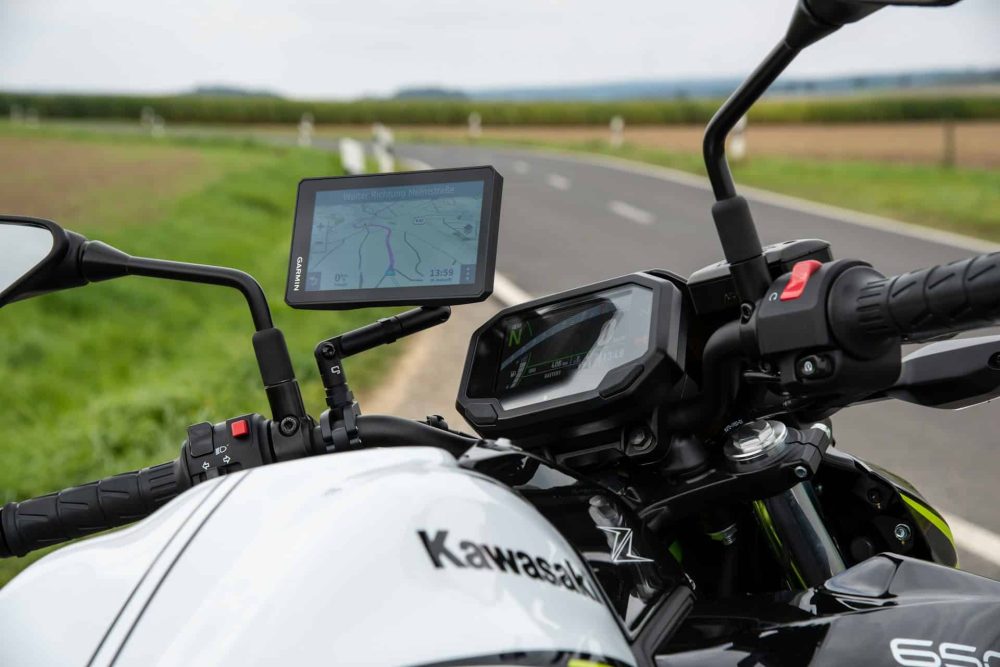
Photo by LouisMoto on Unsplash
So I’m cutting through the crap. Whether you’re chasing twisties or charging across borders, this guide is your map to finding the GPS that actually keeps up.
Motorcycle GPS for the Touring Rider: Smooth Sailing and Smart Screens
Lately, a new breed of device has hit the handlebars, and they’re making a lot of sense for road-focused riders. These units are essentially weatherproof touchscreens that mirror your smartphone, bringing Apple CarPlay or Android Auto to your cockpit.
This means your familiar apps like Google Maps, Waze, Apple Maps, Spotify, and your phone and messaging apps are right there, big and bright. If you’re curious about how these compare to traditional GPS units and full-on adventure setups, check out this deep dive by Robert Baldinger.
CHIGEE AIO-6 LTE: Premium All-in-One Navigation System
After months of testing the Chigee AIO-6 LTE on everything from city heat to wet commutes, this unit has earned its spot as the most feature-complete touring GPS we’ve used. It’s not just a screen—it’s a complete cockpit system.
The 6-inch ultra-bright display (rated 2000 nits) punches through glare like it means it. We’re talking visibility even when the sun’s bouncing off your visor. It runs wireless CarPlay and Android Auto, so you’re using the nav apps you already know.

What Sets it Apart: This isn’t just navigation. The AIO-6 includes:
- Dual 1080p front and rear cameras for continuous ride recording
- Integrated GPS for speed overlays and trip logging
- Real-time tire pressure monitoring (TPMS) with optional sensors
- Lean angle readout for feedback in the twisties
- GoPro and Insta360 control via Bluetooth
- Optional handlebar remote for hands-on-bars control
During our testing, the display stayed bright and responsive in all conditions. The touchscreen works perfectly with gloves, even when wet. Auto-brightness reacts quickly to changing light, keeping maps and controls consistently legible.
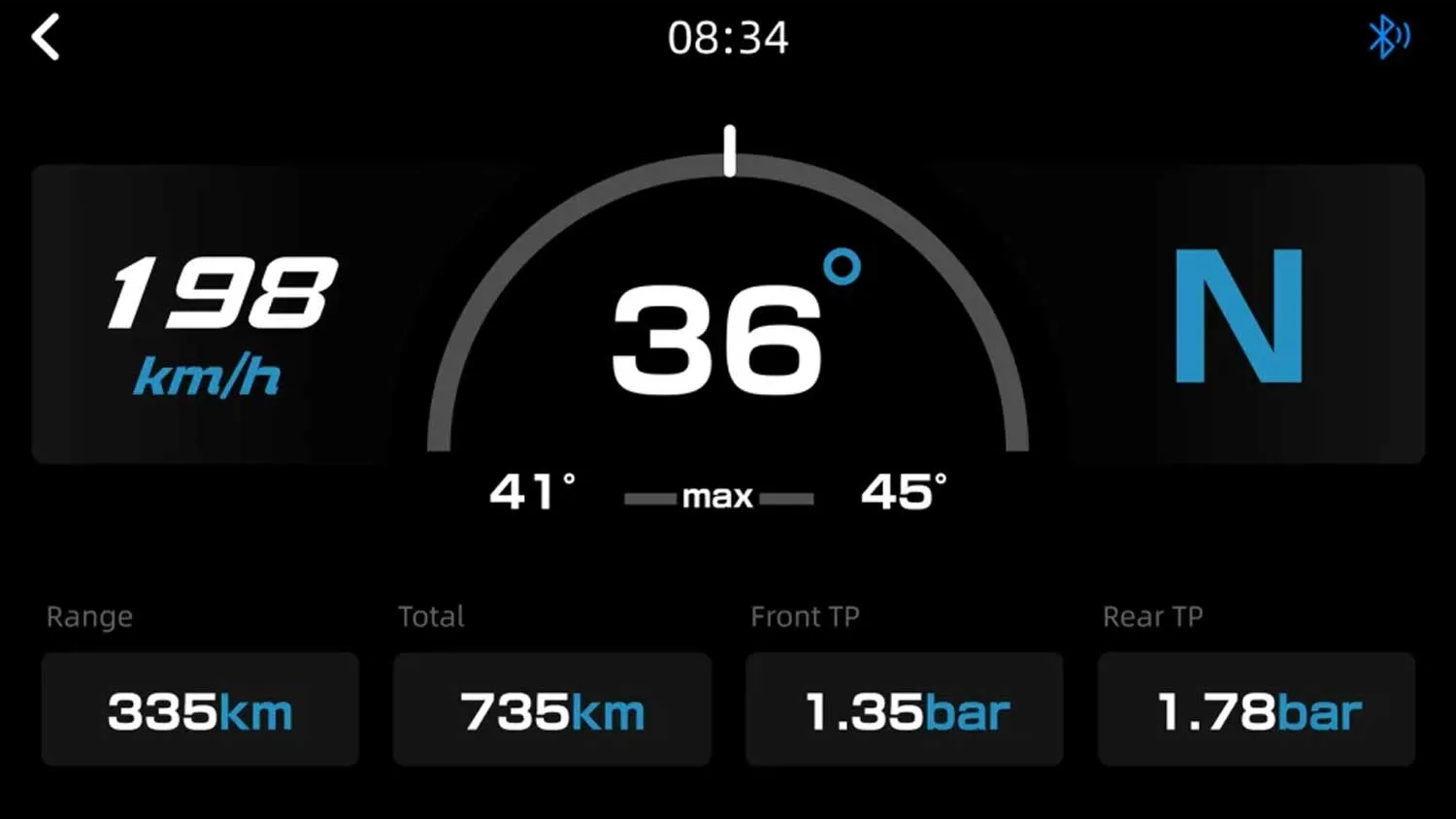
The Lean Angle Feature Surprise Us. What seemed like a gimmick turned into genuine riding feedback. Tip into a familiar corner and watch the number settle where it should. On wet days it reads lower, reminding you to stay within grip. After a few rides, it changed from novelty to genuine riding data—nudging better throttle timing, cleaner lines, and calmer inputs.
The dual cameras delivered sharp footage in daylight with accurate color. In rain, recording didn’t flinch. At night, rear LEDs can wash fine plate detail, but incidents remain clear enough to review. GPS overlays track on-road pace closely enough that a corner sequence tells a story you can learn from.

The Catch? It’s larger and heavier than compact screens. Mounting requires attention—anchor to something stiff, keep it close to minimize leverage, and use just enough isolation to kill buzz without introducing springiness. Done right, the wobble vanishes and the cockpit feels OEM-solid.
The Silver Lining: The AIO-6 doesn’t try to dazzle with a flashy demo reel. It focuses on making the bike feel more composed and the information easier to parse. Set it up thoughtfully, and it delivers. The best gear fades into the background until you need it. After weeks with the AIO-6, a bare bar felt like a step backward.
Our Rating: 4.7/5 – The most complete touring GPS system we’ve tested.
Ready for the full rider-tested breakdown? Check the Chigee AIO-6 LTE review to see how it performs on the road.
CHIGEE AIO-5 LITE: All-in-One Navigation Without the Bulk
We put the Chigee AIO-5 Lite through a brutal 250 km single-day test ride through sun, rain, and dark night conditions. It passed with flying colors.
The 5-inch IPS LCD delivers bright, readable navigation even in direct sunlight. The auto-brightness sensor ramps up quickly, ensuring maps and controls stay visible whether you’re riding through forests or past reflective surfaces.

An hour into our test ride, clear sky turned to heavy downpour. The kind of rain that blurs your visor and slicks the road in seconds. The Chigee didn’t miss a beat. The touchscreen remained fully responsive with water streaming across it. No lag, no glitches. This is the reliability that matters when every distraction could be costly.

What You Get:
- Dual Sony cameras (front and rear 1080p)
- External GPS module for independent satellite lock
- Wireless CarPlay and Android Auto
- Optional TPMS sensors for real-time tire monitoring
- Optional Handlebar remote for hands-free control
- Weather-sealed construction throughout
The dual Sony cameras delivered high-quality footage during our all-day test. Colors are accurate, details sharp, with enough dynamic range to capture both road and sky. In rain, the hydrophobic coating helped water bead off quickly. The cameras auto-start with the bike—no extra buttons to press.
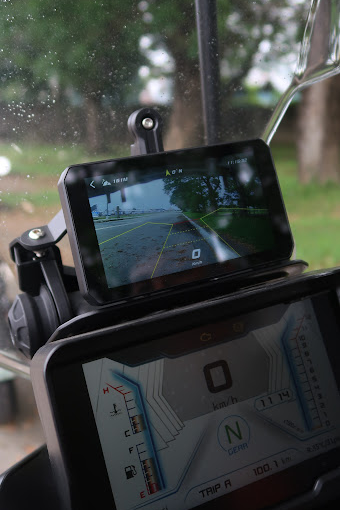
With 4 GB of RAM and a customized Android interface, the AIO-5 Lite performs like a smartphone. Menus open immediately, apps load without delay, and the system responds even if your gloves are wet.
The Catch? The physical size is substantial—great on adventure bikes, but might dominate smaller machines. Installation is complex and takes several hours if you want to use every feature.
The Silver Lining: After our demanding 250 km ride and months of continued use, the AIO-5 Lite has proven reliable where basic systems fail. It consolidates multiple devices into one weather-sealed package that just works.
A compact, handlebar-mounted CarPlay/Android Auto display designed for versatile use across motorcycles paired via Bluetooth with external tire pressure sensors for real-time safety monitoring and seamless ride data integration.
- Simple mount, quick install
- Real-time TPMS via sensors
- Compact, glove-friendly screen
- Dual Bluetooth pairing support
- App-based nav + ride data
- External sensors need battery swaps
- Mounting must avoid vibrations
Our Rating: 4.5/5 – Robust, feature-rich, and built to last.
Want the full hands-on breakdown? Read the Chigee AIO-5 Lite review to see how it performs in everyday riding.
Carpuride W702 Motorcycle GPS
After extensive testing through daily commutes, night rides, and rough road conditions, the Carpuride W702 Pro reveals itself as a capable motorcycle display that handles the essentials exceptionally well at a competitive price.
My girlfriend and I pulled up to our favorite food spot when she realized her phone was still at home. “No music for the ride back,” she sighed. Then I remembered—”Want to try the music sharing feature?” Within seconds, we were both streaming music through our Bluetooth headsets without any configuration. That moment captured what makes the W702 Pro special: it delivers advanced features that actually work.
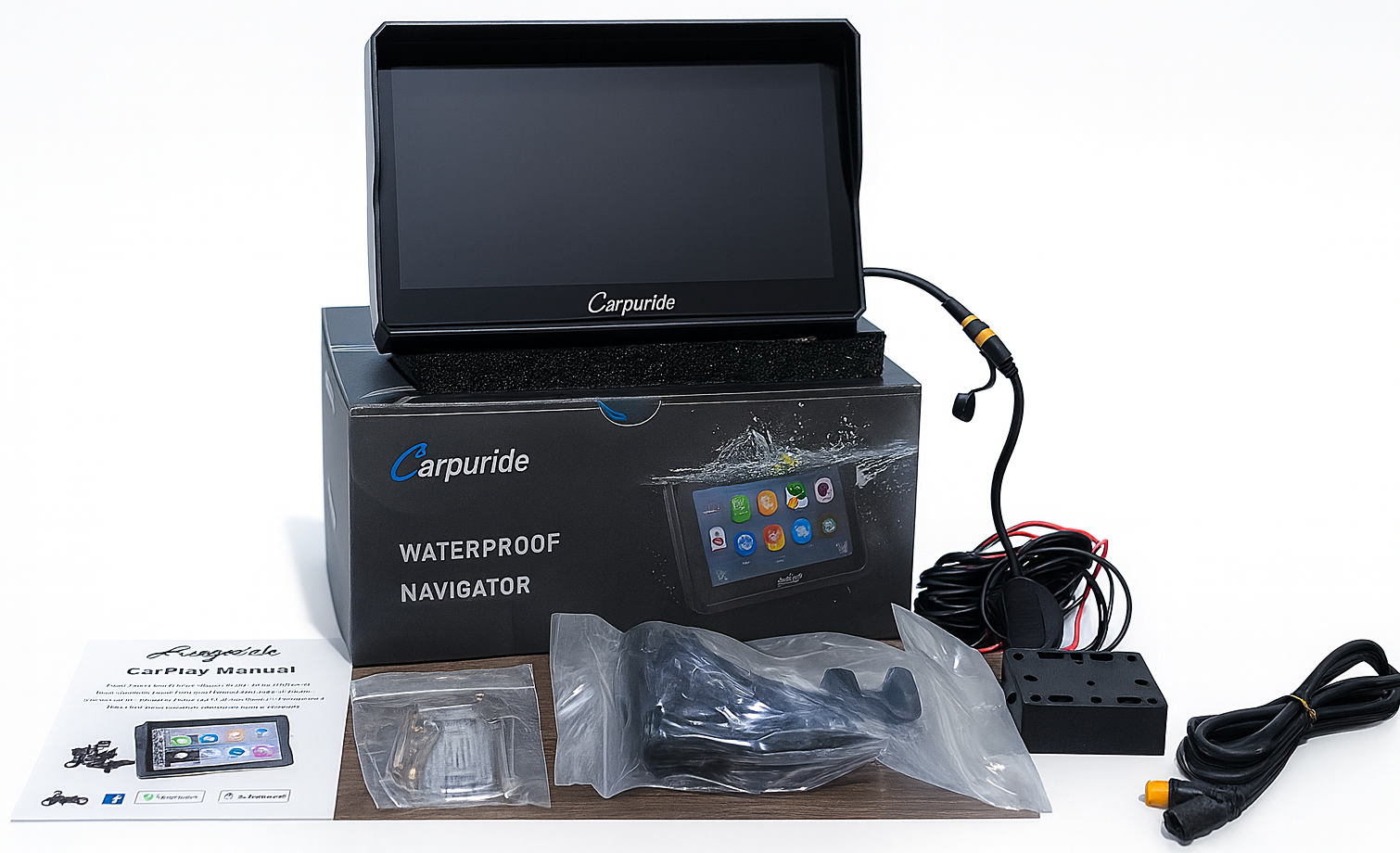
The 7-inch display delivers impressive brightness that stays readable even in direct sunlight. The auto-brightness sensor adapts continuously, smoothing transitions from full sun to shade. There are no harsh jumps or distracting dimming while you ride.
What Impressed Us:
- Exceptional touchscreen responsiveness—registers instantly with thick gloves
- Music sharing that actually works (no configuration needed)
- Fast boot and auto-connection (ready before you fasten your helmet)
- Wireless 5GHz Apple CarPlay and Android Auto
- Flexible USB power option (no hardwiring required)
- IP67 waterproof rating
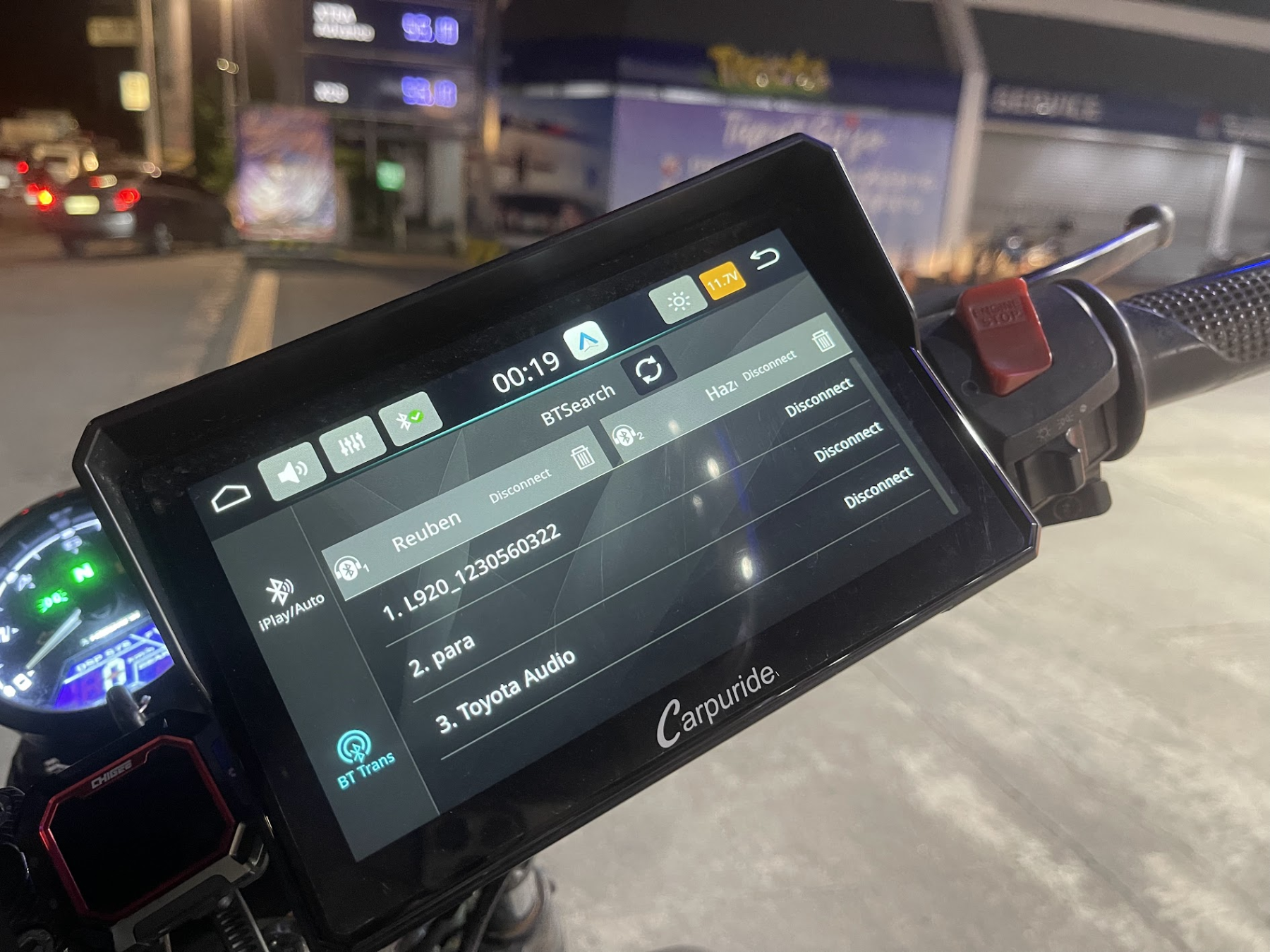
One night, I parked my bike outside and completely forgot to throw the cover on. A heavy rainstorm hit unexpectedly and lasted for hours. The next morning, the bike was soaked—yet the W702 Pro powered right up like nothing happened. The display came to life instantly, touchscreen responsive, audio and CarPlay working perfectly.
The Catch? The mount vibrates noticeably on rough roads around 70 km/h, affecting readability. Google Maps doesn’t auto-switch to dark mode at night (switch to Waze instead). It’s splash resistant, not submarine-proof—angle the screen downward so water sheds faster.
The Silver Lining: At $299, the W702 Pro offers strong value for riders who want a large-screen navigator with wireless CarPlay/Android Auto. The seamless wireless connection and music-sharing feature alone are worth the price. That reliability is a daily quality-of-life upgrade.
A 7" waterproof touchscreen with wireless Apple CarPlay and Android Auto for easy, hands-free access to maps, music, and calls.
- Bright anti-glare IPS display
- Music Sharing
- Wireless CarPlay and Android Auto
- IP67 waterproof rating
- Bluetooth pairing can be tricky
- Setup may be complex for some users
Our Rating: 4.4/5 – Feature-rich, practical, and affordable.
Curious about the W702 Pro’s everyday’s performance? Read the Carpuride W702 Pro review for hands-on feedback.
Beeline Moto II: Minimalist Navigation That Actually Works
AT FIRST GLANCE, the Beeline seems almost too simple. It’s a small, sleek puck with no massive touchscreen, no complex menus. But that’s the entire point. It’s designed to do one job—show you where to turn—and do it perfectly, without distracting you from the ride.
The Beeline has completely solved navigation chaos for me. Its super simplified interface makes it incredibly easy to see exactly what turn I need to take with a quick glance. I can process the clear, visual arrow much faster than a voice command, which means my eyes are back on the road sooner.
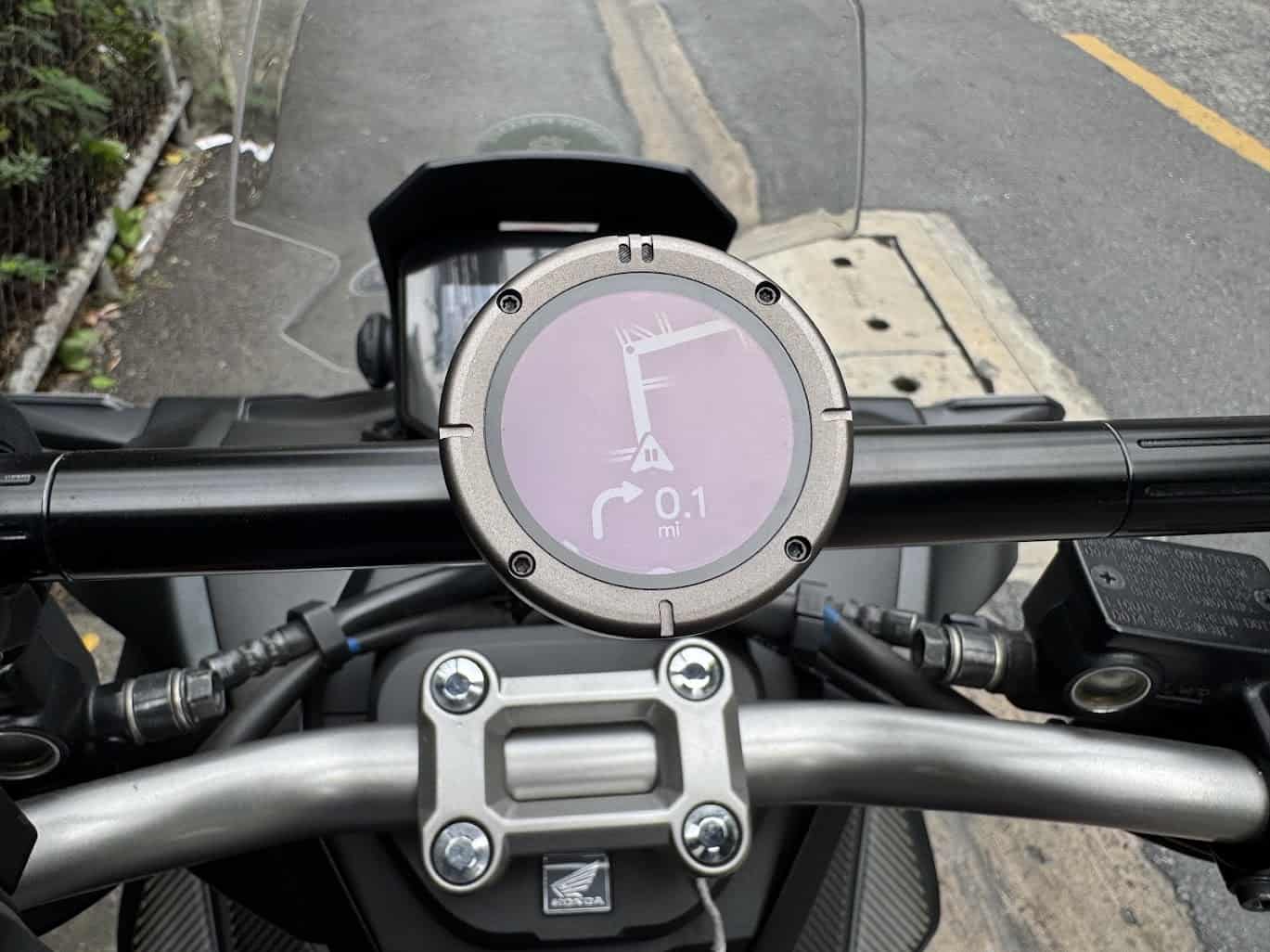
What I Love:
- Clean interface designed specifically for motorcycling
- Brilliant anti-reflective coating with zero glare at any angle
- Incredible battery life (lasts weeks on a single charge)
- Automatic and instant light adjustment (tunnels, bright sun, everything)
- Smooth twist-and-lock mount (easier than Quad Lock or SP Connect)
- Distraction-free: no notifications, no tempting apps
- Bright LED turn indicators plus subtle audible cues
- Full-color display (much better than first-gen)
We shared test units with our friends Stephen from MotoStories and More and Mel from CafeRacerNYC. Mel tested it extensively in New York City:
“I’ve ridden with RAM, Quad Lock, Sena, Cardo — you name it. I was honestly skeptical that something this tiny could keep up in NYC chaos,” Mel told us.
His ride logs showed impressive performance:
- Lower Manhattan’s tight corners? “The arrow-based system handled it with speed and simplicity—no clutter, no second-guessing.”
- Grand Central Tunnel’s sudden darkness? “The display adjusted instantly.”
- High speeds crossing Williamsburg Bridge? “Audible beeps came through clearly even with a full-face helmet.”
- Rain on West Side Highway? “Kept my phone in my waterproof pocket. Less stress about rain damage or theft.”

The Catch? You have to rebuild routes in the Beeline app or export GPX files (extra step for Google Maps power users). The arrow UI takes time to trust—if you’re used to full map views, it feels barebones at first. Device controls have a learning curve (short-press vs long-press).
The Silver Lining: The Beeline eliminates all the frustrations of using a phone while providing visual clarity that voice commands can’t match. It’s made our daily rides less stressful and more enjoyable—adding function while reducing distraction.

Vs. Phone Mount: A phone gives full detailed maps but with downsides—camera vibration damage risk, battery drain, overheating, screen glare. Beeline solves all these problems.
Vs. Full GPS Unit (Garmin Zumo XT2): Garmin offers huge screens, complex trip planning, and independence from your phone. But it’s bulky, expensive, and overkill for daily urban commuting or bikes with classic styling. Beeline is the minimalist, elegant solution.
Our Rating: 4.5/5 – Perfect for urban riders and minimalists who want distraction-free navigation.
Curious how a compact nav unit performs on the road? Read our Beeline Moto II review for visuals, mounting tips & feedback.
CHIGEE XR-2: Compact CarPlay for Classic Bikes
We mounted the Chigee XR-2 on a 1990 Yamaha XJR 400 to see if modern tech could work on a classic machine without overwhelming its character. It succeeded beautifully.
The 4.3-inch display might seem small, but Chigee optimized it perfectly for motorcycle use. At 1400 nits brightness, it delivers exceptional visibility even in direct sunlight. The compact form factor means it looks right at home on smaller bikes, classic machines, and sport bikes where larger units would dominate.

On our XJR 400 test bike, the XR-2 looked as though it could have been a factory option if the technology had been available in 1990. Its unobtrusive presence allows the bike’s original character to shine through while offering modern functionality.
Features That Matter:
- Built-in GPS (no external module needed)
- Wireless Apple CarPlay and Android Auto
- Dual 1080p cameras
- IP68 waterproof rating (highest available)
- Optional TPMS sensors
- Smart auto day/night mode switching
- Dashboard integration with odometer display
During a storm on the expressway, we watched rain cascade across the XR-2’s screen, yet it continued to operate without issue. The touch response remained steady, even with wet gloves, and the display brightness automatically adjusted to maintain visibility.
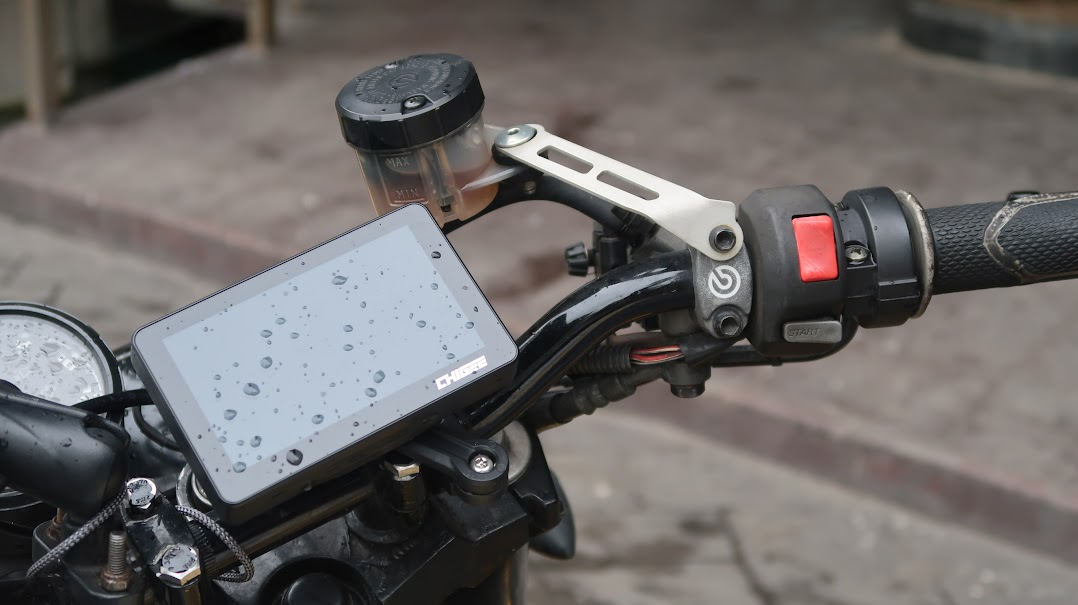
The build quality extends beyond just weather resistance. The mounting system integrated cleanly with the XJR’s handlebars without requiring multiple brackets or complex installation procedures. This matters significantly for riders of classic machines who value clean installations and have limited space to work with.
The Catch? No buttons—you’ll need the optional Bluetooth remote for safest operation. The smaller screen size won’t suit everyone, especially those accustomed to tablet-sized displays.
The Silver Lining: For riders of classic, vintage, or smaller displacement motorcycles, the XR-2 delivers exactly what’s needed without excess complexity or bulk. It enhances your riding experience without dominating it.
The XR-2 is a compact, handlebar-mount CarPlay / Android Auto “smart riding” display and dashcam unit for motorcycles. It features a 4.3-inch touchscreen that mirrors your smartphone interface, dual front/rear cameras for recording, and optional external tire pressure sensors for real-time monitoring. It integrates navigation, ride logging, and safety features into one compact system.
- 1400 nits brightness, daylight ready
- Dual cams for recording + safety
- CarPlay / Android Auto support
- Optional TPMS external sensors
- IP68 water + dust resistant
- More affordable than flagships
- No buttons, needs BT remote
- No blind-spot detection
Our Rating: 4.6/5 – Perfect for riders who value proportional design and essential functionality.
Curious how the XR-2 stacks up in everyday riding? Read the Chigee XR-2 review and get insights on fit, performance, and installation.
Garmin Zūmo XT2
If you’re chasing horizon lines for days at a time, the Garmin Zumo XT2 is the kind of GPS that actually keeps up. This thing doesn’t just show you where to go. It turns the ride into something you plan, explore, and share like a pro.
The 6-inch HD display is bright enough to beat back sun glare, rain, dust, and anything else you throw at it. It’s glove-friendly, fully waterproof, and rated to survive drops, vibes, and weather that would make a smartphone cry. This is gear made for the long haul.
What sets it apart is the routing. You get full North American street maps preloaded, plus Garmin’s twisty road finder built in. Want to avoid highways and hit every backroad twist between states? Done. It throws in rider alerts too—tight turns, wildlife crossings, speed shifts. The Tread app syncs it with your phone for live traffic, weather, and shared group rides, but the core nav runs totally standalone.
Bluetooth support is tight. You can stream music and take calls through your helmet setup without weird delays or connection drops. And planning routes in the Garmin ecosystem is smoother than ever. Pick points of interest, adjust elevation profiles, and send it straight to the device.
This isn’t your budget-friendly display screen. But it earns its price by working when your phone’s toast and the trail’s gone to hell.

The catch? It costs more than most CarPlay setups, and there’s a bit of a learning curve if you’re used to phone apps only.
The Silver Lining: It’s a powerhouse GPS with no phone needed. Maps, routing, weather, and safety features baked in—and it holds up when everything else fails.
Alternative option: If you’re on a tighter budget and okay relying on your phone for navigation, the Carpuride W702 offers wireless CarPlay and Android Auto in a bright, waterproof 7-inch package.
The Zumo XT2 is a rugged 6" motorcycle GPS with a bright touchscreen, built for both road touring and off-road rides. It offers group tracking and smart navigation.
- Bright, glove-friendly 6" HD screen
- Real-time group ride tracking
- Easy switch between street, topo, and satellite maps
- Tread app can be buggy
- Not compatible with Garmin BaseCamp
- Audio prompts may be too quiet over Bluetooth
Our rating: 4.8 / 5. The Zumo XT2 is the go-to GPS if you want bulletproof touring tech with serious off-road chops on the side.
Motorcycle GPS for the Adventure Rider: Built Tough for the Rough Stuff
If you ride ADV, you already know. It’s not just about getting there. It’s about getting lost, finding weird roads, and pushing past where the map ends. Dirt, gravel, river crossings, goat trails. That’s the good stuff. But to pull it off, your GPS needs to be more than a pretty screen. It needs to take hits, run complex GPX tracks, and keep you locked in when cell signal is just a rumor.
Robert Baldinger gets it. He’s a machine when it comes to adventure nav setups. His breakdowns, like Mastering Adventure Ride Navigation: Syncing, Gpx Files, Routes, are pure gold. Whether you’re strapping a phone to your bars or building a full custom rig, he lays it out clean. And if you’re riding off-pavement, learning how to load, edit, and follow GPX files isn’t optional. Robert drills that in and he’s dead right. If your GPS can’t handle a loop through nowhere, it’s not built for this game.
Garmin Tread 2 Powersport 6″ GPS Navigator
When the trail disappears and the map turns to guesswork, the Garmin Tread 2 keeps you locked in. This thing isn’t just built tough, it’s built smart, with the kind of off-road brains that make it a must-have for riders who live for the backcountry.
The 6-inch HD screen is glove-friendly and bright enough to cut through sun glare, rain, and dust. It’s IPX7 waterproof, IPX6 dustproof, and MIL-STD-810 rated for drops. That means it shrugs off the kind of abuse that would send your phone crying back to the glovebox.
But it’s the mapping that sets it apart. The Tread 2 comes preloaded with topographic maps, public and private land boundaries, and off-road points of interest. It even includes USFS Motor Vehicle Use Maps and Garmin’s Adventure Roads and Trails network. And if that’s not enough, you can download satellite imagery without a subscription, so you’re never riding blind.
Planning routes is a breeze with the Tread app. You can design your own or download GPX tracks, and the Tread 2 will give you turn-by-turn directions—even on unpaved roads and trails. Pair it with a Bluetooth helmet comm, and you’ll get voice prompts so you can keep your eyes on the trail.
The Tread 2 also plays nice with Garmin’s other gear. You can control your vehicle’s light bars, sound system, or onboard cameras right from the device. And if you’re riding with friends, the Group Ride feature lets you share GPX files and track each other in real time, provided you have a data connection.
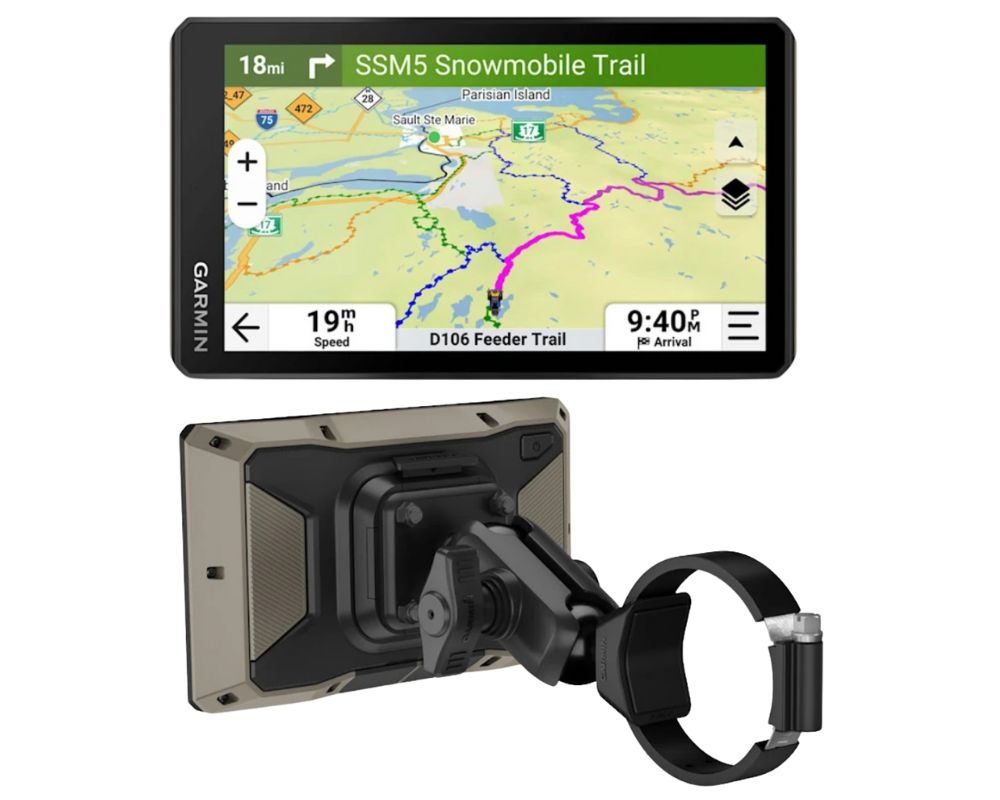
The catch? While the Tread app is powerful, it has a learning curve that might frustrate some users.
Silver lining: The Tread 2 offers a rugged, feature-rich navigation experience that doesn’t rely on your phone. With detailed maps, satellite imagery, and seamless integration with other Garmin devices, it’s a solid choice for serious off-road adventurers.
Alternative option: If you’re looking for a more road-focused GPS with a larger screen, the Garmin Zumo XT2 offers similar features tailored for on-road touring.
A rugged 6" GPS built for off-road and on-road powersports, with glove-friendly touchscreen, topo maps, and group ride tracking.
- IP67 water and dust resistance
- Preloaded topo maps and satellite imagery
- Group ride tracking via Tread app
- Limited internal storage
- Touchscreen less responsive with gloves
- Handlebar remote sold separately
Our rating: 4.7 / 5 – A robust and intelligent GPS that excels in off-road navigation, making it a great option for adventure riders.
Trail Tech Voyager Pro GPS Kit
When you’re deep in the backcountry, far from cell towers and paved roads, you need a GPS that won’t quit. The Trail Tech Voyager Pro is built for riders who thrive off the grid. It’s not just a navigation device; it’s a rugged companion designed to keep you connected and informed in the most remote terrains.
The 4-inch color touchscreen is glove-friendly and remains visible under direct sunlight. It comes preloaded with topographic maps and allows for GPX file import/export, enabling you to plan and record entire trail systems. The device also displays critical data like speed, temperature, distance, elevation, and voltage, ensuring you’re always aware of your ride’s status.
One standout feature is the Buddy Tracking system. Using sub-gigahertz radio signals, it connects up to 20 riders without relying on cellular service. This mesh network lets you see your group’s location in real-time, enhancing safety and coordination during group rides. An emergency beacon function adds an extra layer of security, signaling your location to your buddies if needed.
Bluetooth connectivity allows for seamless integration with your phone and headset. You can control music, adjust volume levels, and access call and messaging features directly from the Voyager Pro. It’s compatible with popular headset brands, ensuring you stay connected without distractions.
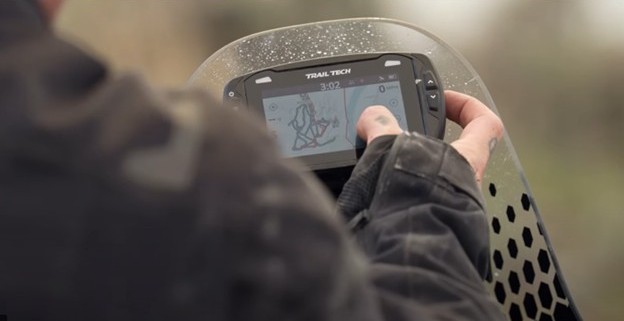
The catch? The Voyager Pro lacks turn-by-turn navigation, which might be a drawback for those accustomed to that feature. Additionally, the device can be power-hungry, especially with Buddy Tracking active, so it’s advisable to wire it to a switched power source to prevent battery drain.
Silver lining: For off-road enthusiasts, the Voyager Pro offers a comprehensive suite of features tailored to rugged adventures. Its robust build, real-time group tracking, and detailed ride data make it an invaluable tool for serious riders.
Alternative option: If you’re seeking a GPS with turn-by-turn navigation, consider the Garmin Montana 700i. This rugged device features a 5-inch glove-friendly touchscreen, preloaded topographic maps, and supports satellite imagery.The Montana 700i offers inReach technology for two-way messaging and SOS alerts, making it a reliable companion for remote adventures. It’s designed to withstand harsh conditions, ensuring durability on your rides.
A rugged 4" off-road GPS with real-time Buddy Tracking, Bluetooth connectivity, and vehicle sensor integration.
- Real-time group tracking (no cell needed)
- Bluetooth for music and comms
- IP67 waterproof touchscreen
- No turn-by-turn navigation
- High power usage with tracking
- Dock connection can loosen over time
Our rating: 4.6 / 5 – A reliable and feature-rich GPS designed for off-road adventures, offering real-time tracking and comprehensive ride data for the dedicated rider.
Special Mention: Your Lifeline When Things Go Sideways
Garmin inReach Mini 2
This isn’t your main nav tool, and it doesn’t try to be. But when the ride takes you past the last cell tower and into true nowhere, the Garmin inReach Mini 2 becomes the most important piece of gear you’re carrying.
It’s a satellite communicator the size of a granola bar, built to keep you alive when things go sideways. You can trigger an SOS from anywhere on earth, and it pings Garmin’s 24/7 emergency coordination center. Break a leg. Bike dies. Lost in the woods. Doesn’t matter. Help will know where you are, and they’ll come.
You can also send and receive texts through the Iridium network. Let folks know you’re okay, drop an update on your progress, or just say you’ll be late to camp. It tracks your route, marks waypoints, and can pair with your phone or a Garmin GPS for easier messaging and trip planning.
Battery life is long. Build quality is tough. It’s waterproof, compact, and designed to work where your phone just gives up. Yes, it needs a satellite subscription, but that price is nothing compared to the peace of mind it buys.
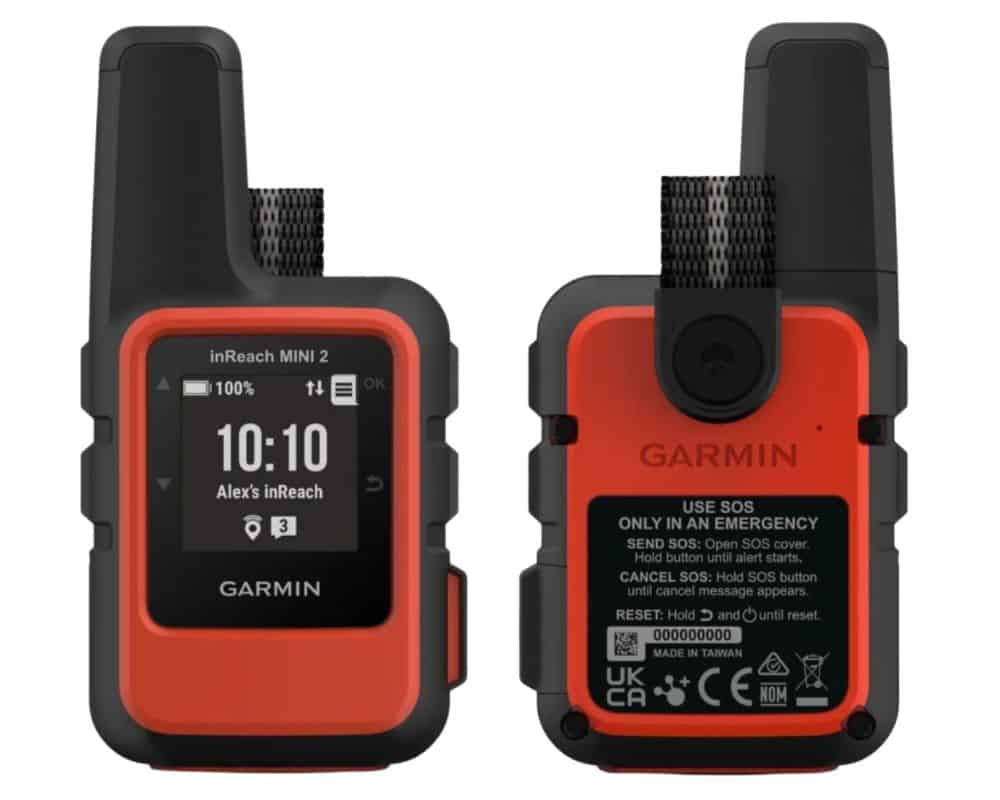
The catch? No full-color maps, no fancy routing. Messaging on the device is slow and clunky. You’ll want to pair it with your phone or GPS to get the most out of it.
Silver Lining: It does one thing and does it flawlessly. You’re never truly out of reach with this clipped to your kit.
Alternative option: There isn’t a real substitute, but you may consider the ZOLEO Satellite Communicator, which offers similar two-way messaging and SOS capabilities.
A compact satellite communicator offering global two-way messaging, SOS alerts, and GPS tracking—ideal for off-grid adventures.
- Reliable global Iridium satellite coverage
- Long battery life (up to 30 days)
- Lightweight and rugged (3.5 oz, IPX7 rated)
- Garmin
- Messaging is easier via paired smartphone
- Requires a monthly subscription
- No built-in maps or color display
Our rating: 4.9 / 5. A must-have for riders who disappear into the wild. It’s small, quiet, and absolutely clutch when everything else goes wrong.
Comparison Table
| Device | Best For | Screen | Nav Mode | Cameras | TPMS | IP Rating | Features | The Catch |
| Chigee AIO-6 LTE | Touring, data-rich cockpit | 6″, ~2000 nits | Wireless CarPlay / Android Auto + built-in GPS | Dual 1080p | Optional | IP69K | Lean-angle data, GoPro/Insta360 control | Larger/heavier; needs solid mount setup |
| Chigee AIO-5 Lite | ADV / Touring all-in-one | 5″ IPS (bright) | Wireless CarPlay / Android Auto + built-in GPS | Dual 1080p (Sony IMX Sensor) | Optional | IP67 | Hydrophobic lenses, fast UI, glove-friendly when wet | full-feature install takes hours |
| Carpuride W702 Pro | Value, big-screen road use | 7″ (bright) | Wireless CarPlay / Android Auto | — | — | IP67 | Music sharing, fast boot/auto-connect, USB power option | Mount wobble on rough roads |
| Beeline Moto II | Minimalist urban/commute | Small, anti-glare | Beeline arrow UI via phone | — | — | IP67 | Weeks-long battery, instant light adjustment, twist-lock mount | Must build routes in app/GPX |
| Chigee XR-2 | Classic/vintage, small cockpit | 4.3″, ~1400 nits | Wireless CarPlay / Android Auto + built-in GPS | Dual 1080p | Optional | IP68 | Compact, clean install, auto day/night | No physical buttons; remote recommended |
| Garmin Zūmo XT2 | Touring + light ADV | 6″ HD | Standalone maps; phone optional | — | — | IPX7 | Twisty-road routing, rider alerts, offline maps, Tread app | Pricey |
| Garmin Tread 2 (6″) | Serious ADV/backcountry | 6″ HD | Standalone topo + satellite imagery | — | — | IP67 | Public/private land maps, USFS MVUM, Group Ride | Powerful but steeper |
| Trail Tech Voyager Pro | Dirt/off-grid group rides | 4″ | GPX tracks | — | — | IP67 | Buddy Tracking (no cell), rich bike data | No turn-by-turn |
| Garmin inReach Mini 2 | Emergency safety backup | Satellite SOS/comms | — | — | IPX7 | Global SOS, two-way satellite texts, tiny & light | Subscription; no maps/routing |
Buying Guide: Picking Your Perfect Motorcycle GPS
Okay, that was a lot of info! So, how do you choose the right GPS for your ride? Let’s break it down:
What Kind of Riding Do You Actually Do?
- Mostly Road Touring, Day Trips, Commuting: If you stick to the tarmac and love the convenience of your phone’s apps, a CarPlay/Android Auto screen (LAMTTO, Aoocci, Carpuride) is probably your best bet. They’re relatively affordable, offer great screen visibility, and use the navigation apps you already know and love. The TomTom Rider 550 is also a great choice here if you prefer a dedicated GPS and love its “winding roads” feature.
- Serious Adventure & Off-Road: If you’re hitting BDRs, exploring remote trails, and need robust GPX support and detailed off-road maps, you need something tougher. The Garmin zūmo XT2 is the king here for its blend of usability and capability. The Garmin Tread 2 is even more specialized for off-road and group rides. For dirt bike riders wanting bike data, the Trail Tech Voyager Pro is unique. The Magellan TR7 Cam is an option if US trail maps and a built-in camera appeal.

- A Bit of Everything (Touring with some Light Adventure): The Garmin zūmo XT2 shines brightly here. It’s fantastic on the road and equally competent when the pavement ends.
How Important is Smartphone Integration?
- Love CarPlay/Android Auto: Then the choice is clear: LAMTTO, Aoocci, or Carpuride. You get seamless integration with your phone for maps, music, calls, and texts.
- Prefer a Standalone Unit: If you want your GPS to be self-sufficient and not reliant on your phone (or you often ride where there’s no cell signal for app-based enhancements), then a dedicated unit like the TomTom Rider 550, Garmin zūmo XT2, or Garmin Tread 2 is the way to go. These have all the maps and core navigation built-in.
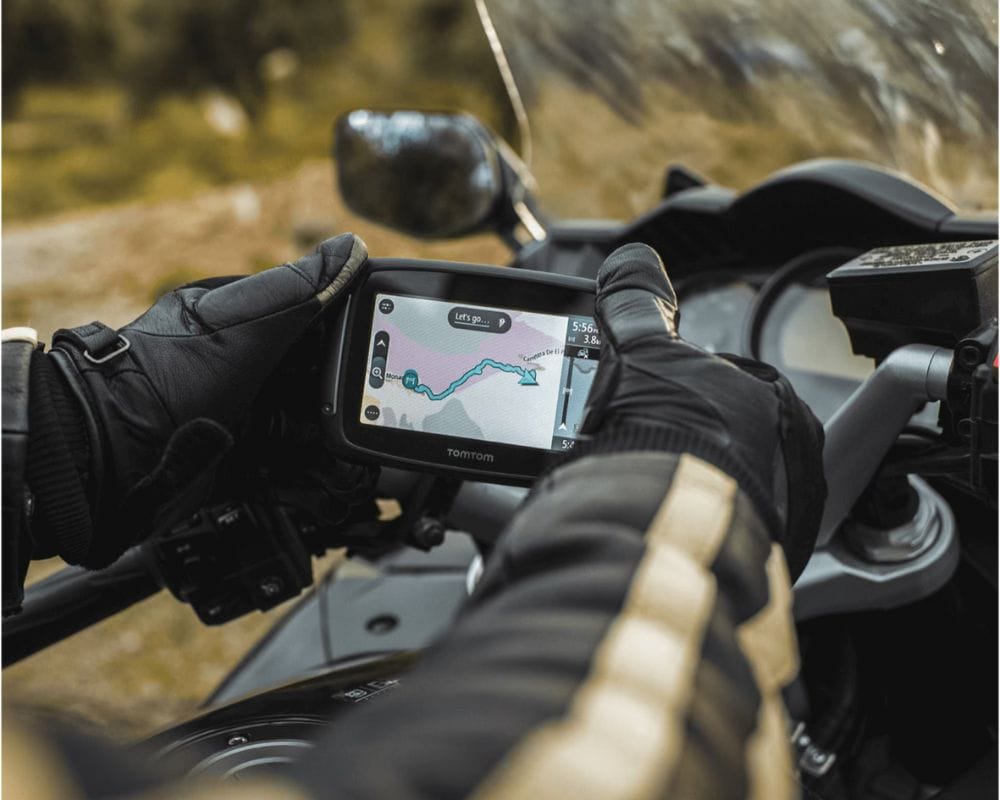
What’s Your Budget?
- Budget-Conscious: The CarPlay/Android Auto units generally offer the best bang for your buck for on-road navigation.
- Mid-Range: The TomTom Rider 550 and Trail Tech Voyager Pro sit here.
- Premium/Invest for the Long Haul: The Garmin zūmo XT2 and Tread 2 are top-tier investments but offer incredible features and durability. Remember, the Garmin inReach Mini 2 also has an upfront cost plus a recurring subscription, but its safety value is immense.
Key Features to Consider:
- Screen Size & Visibility: Bigger isn’t always better if it obstructs your view, but for easy glances, a 5-7 inch screen is great. Brightness (measured in nits) is crucial for sunlight readability.
- Ruggedness & Waterproofing: Look for at least an IPX7 rating for waterproofing. For adventure riding, MIL-STD-810 (military standard for toughness) is a big plus (found on the XT2 and Tread 2).
- GPX Route Handling: Essential for adventure riding. Check how easy it is to import, manage, and follow GPX tracks. Garmin’s Tread app ecosystem is very good for this.
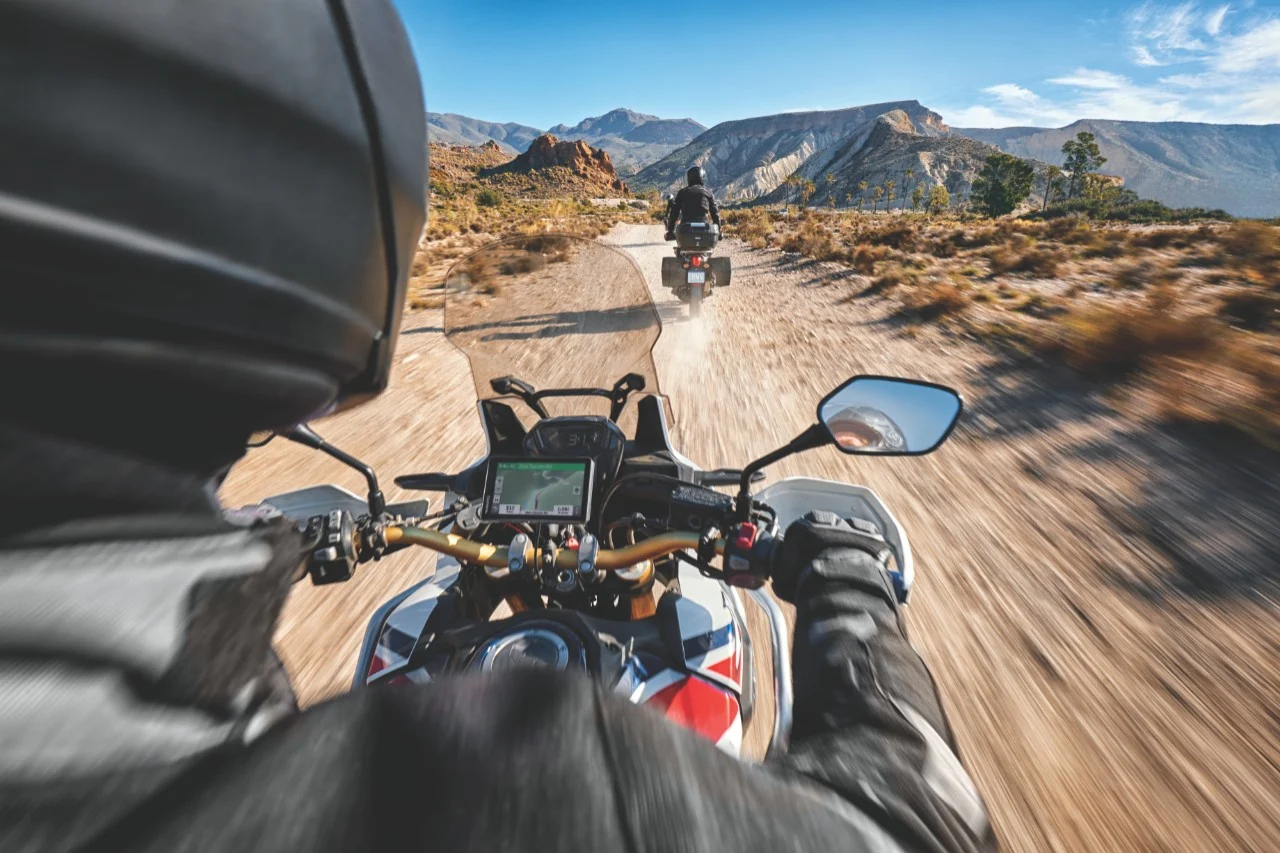
- Battery Life & Power: Most units are designed to be hardwired to your bike’s battery for continuous power. Internal battery life is more for short stops or planning off the bike.
- Ease of Use: A complicated interface is frustrating and distracting. CarPlay/Android Auto units are generally very intuitive if you’re used to your phone. Garmins have a learning curve but are very powerful once mastered.
Don’t Forget the “What Ifs”
For any kind of remote riding, even if it’s just a day trip into areas with spotty cell service, seriously consider a satellite communicator like the Garmin inReach Mini 2. It’s not for navigation, but for getting help when you absolutely need it.
Frequently Asked Questions
Is a motorcycle GPS worth it?
If you ride often, especially outside city limits or into unfamiliar terrain, absolutely. A good moto GPS is built to survive weather, vibration, and gloves. Unlike a phone, it won’t overheat, die in the rain, or lose signal when you need it most.
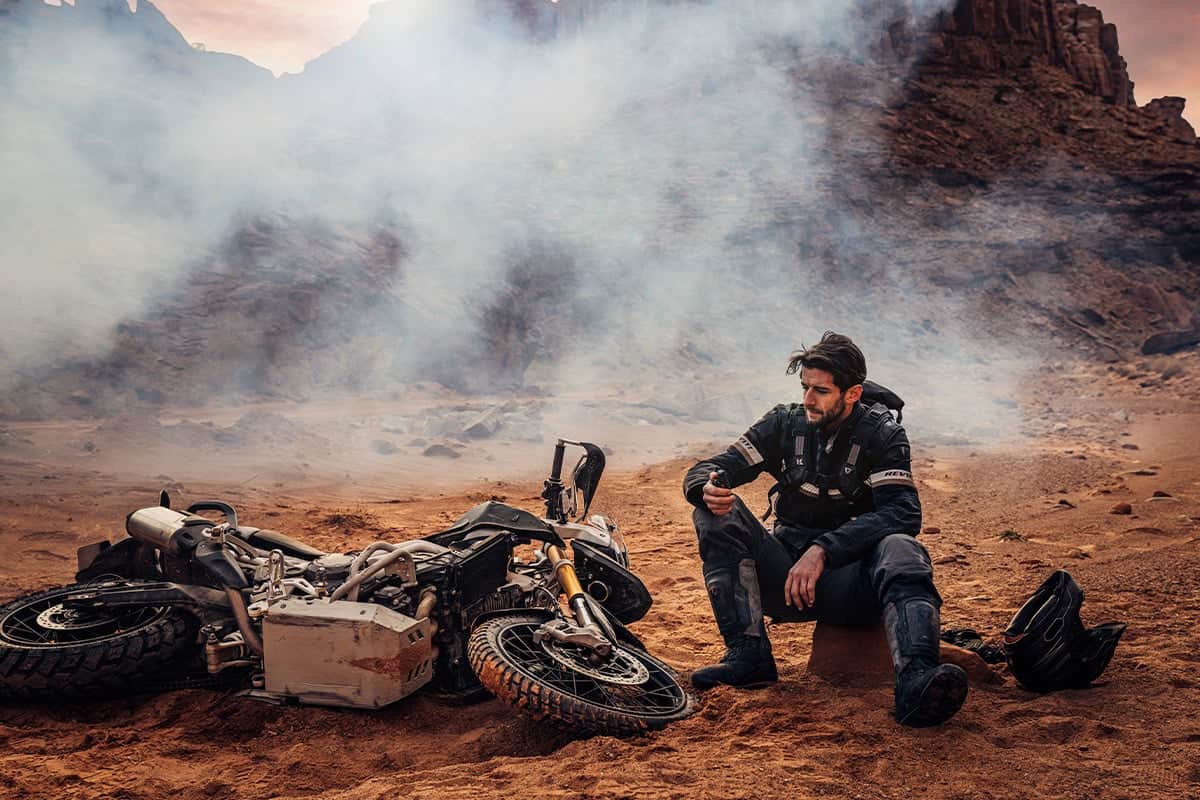
How accurate are GPS bike computers?
They’re usually spot-on for location and tracking, especially when they lock into multiple satellite networks like GPS, GLONASS, or Galileo. You’ll get reliable data for speed, route, and elevation. Just don’t expect pinpoint lane guidance in a canyon at 80 mph.
How accurate is Google Maps for bikes?
Pretty solid on pavement. Not so great off-road or in the backcountry. It’s built for traffic and cars, so when the trail turns rough or disappears, you’re better off with GPX tracks or topo maps.
6″ IP69 motorcycle display with CarPlay/Android Auto and 4G LTE for stand-alone nav, geofence/SOS security, live tracking, and 2000-nit daylight visibility. | Waterproof, glove-friendly bar mount that mirrors your phone for clear, anti-glare navigation—simple, reliable, adventure-ready. | A 7" waterproof touchscreen with wireless Apple CarPlay and Android Auto for easy, hands-free access to maps, music, and calls. |
|
|
|
|
|
|
6″ IP69 motorcycle display with CarPlay/Android Auto and 4G LTE for stand-alone nav, geofence/SOS security, live tracking, and 2000-nit daylight visibility.
- Wireless CarPlay/Android Auto
- Built-in dashcam
- Bright 5″
- Quick install
- IP69K
- LTE data cost
- Higher power draw requires stable wiring
Waterproof, glove-friendly bar mount that mirrors your phone for clear, anti-glare navigation—simple, reliable, adventure-ready.
- Glove-friendly, anti-glare display
- Lightweight, waterproof, no wiring
- Quick/fun routing; ~14 h battery
- Compact—keeps bars clean
- No hard-wired charging
A 7" waterproof touchscreen with wireless Apple CarPlay and Android Auto for easy, hands-free access to maps, music, and calls.
- Bright anti-glare IPS display
- Music Sharing
- Wireless CarPlay and Android Auto
- IP67 waterproof rating
- Bluetooth pairing can be tricky
- Setup may be complex for some users
Which GPS app is most accurate?
If you’re sticking to pavement, Google Maps or Waze will get you there clean. Off-road? Go with Gaia GPS, OsmAnd, or Garmin’s Explore app. They’re built for the wild and don’t bail when things get bumpy.
Ultimately, the “best” motorcycle GPS is the one that fits your specific needs, riding style, and budget. Hopefully, this guide has given you a much clearer picture of what’s out there and what to look for. Do your research, maybe watch a few video reviews of your top choices, and then get ready to explore with more confidence than ever before.
Happy navigating!
Related
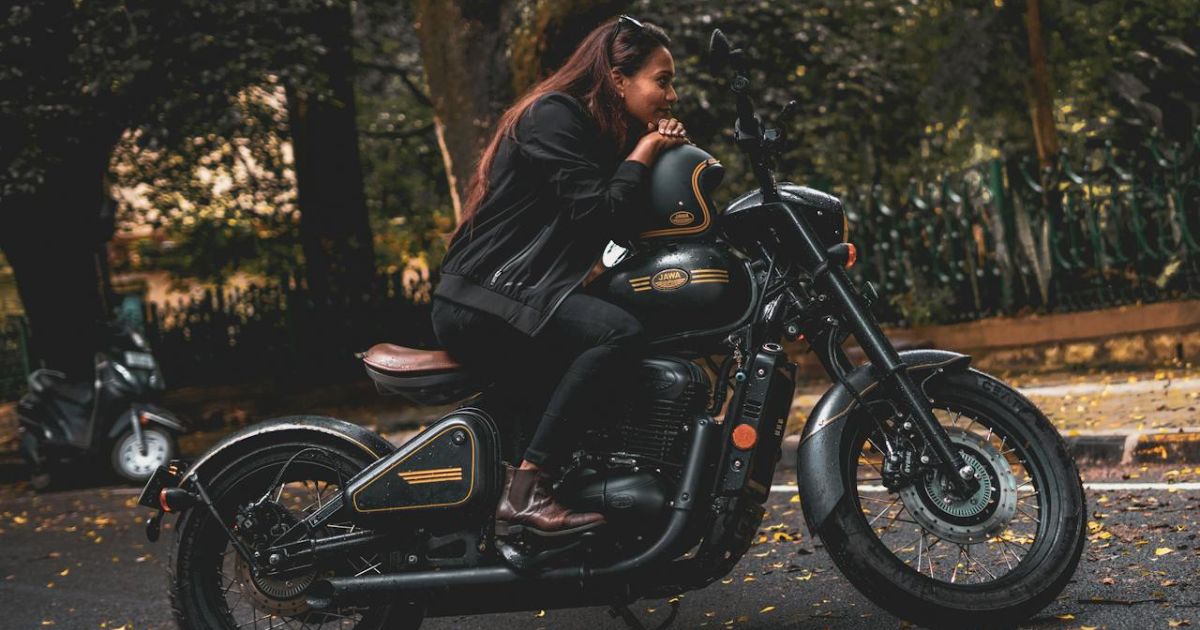
Best Motorcycle Gear for Women: Stylish, Safe & Confident
Discover the best motorcycle gear for women—tested for protection, comfort, and style to keep every rider confident, cool, and safe on the road.

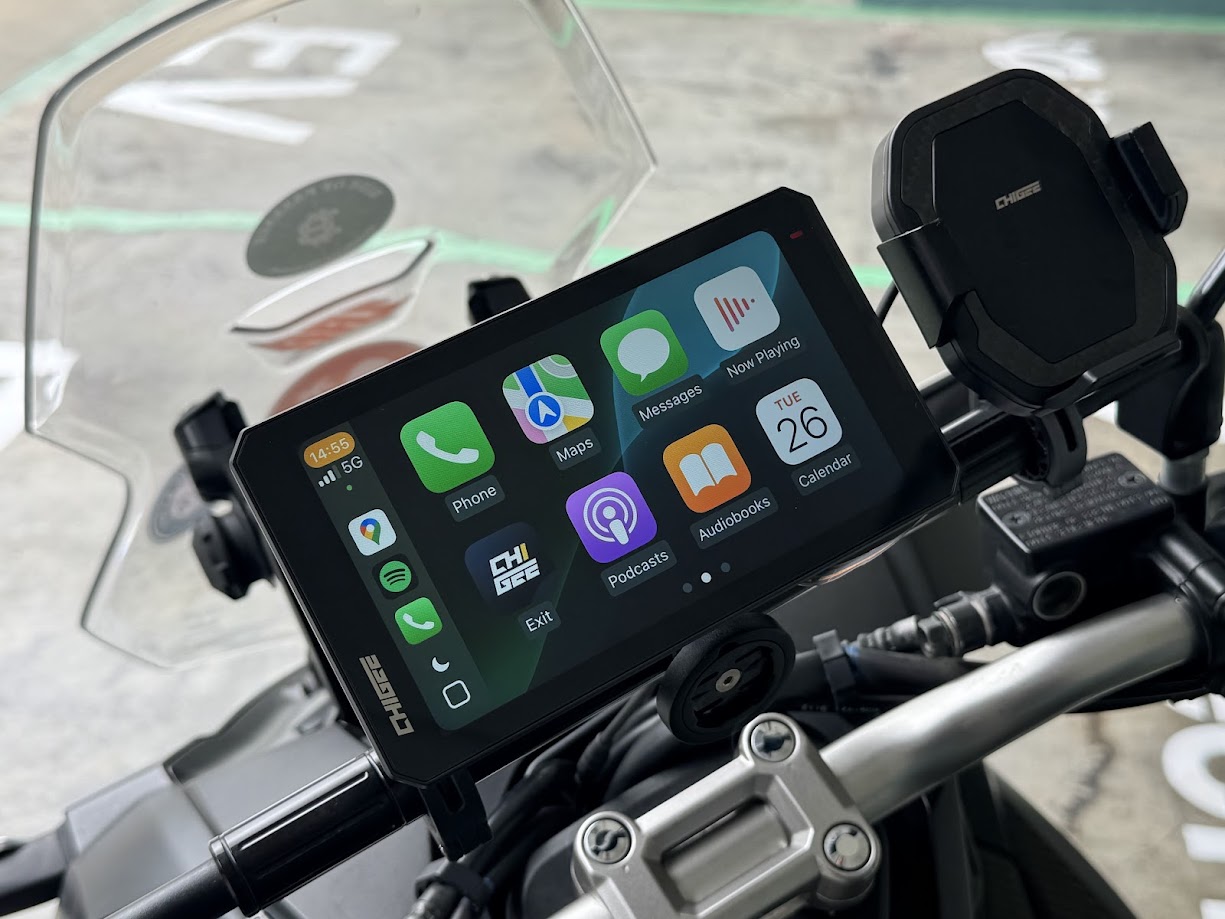

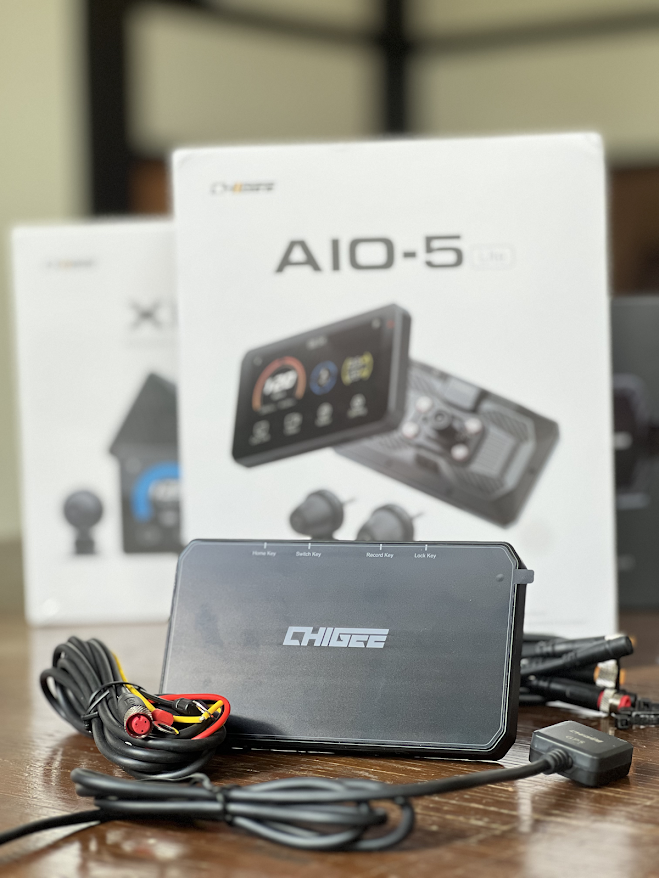
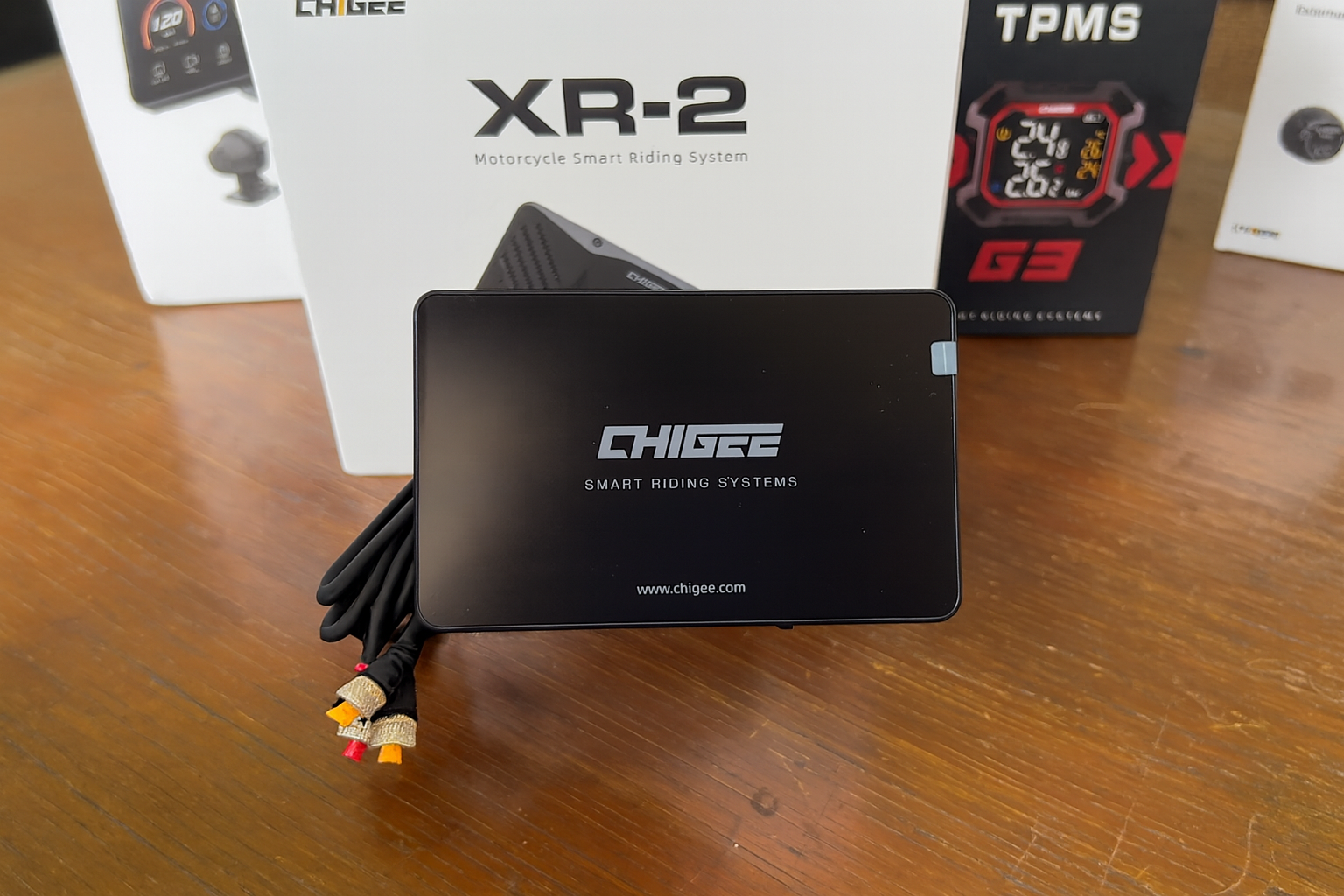
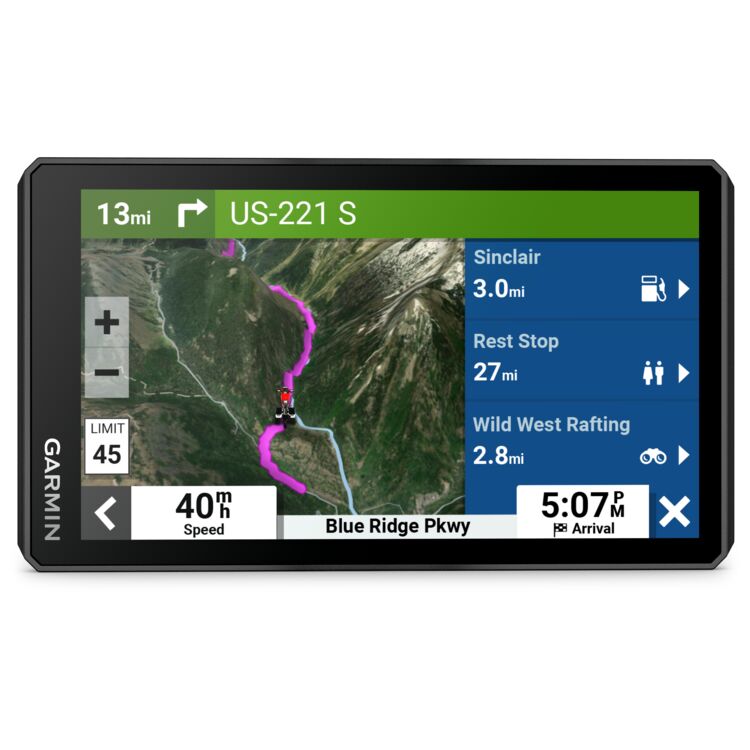
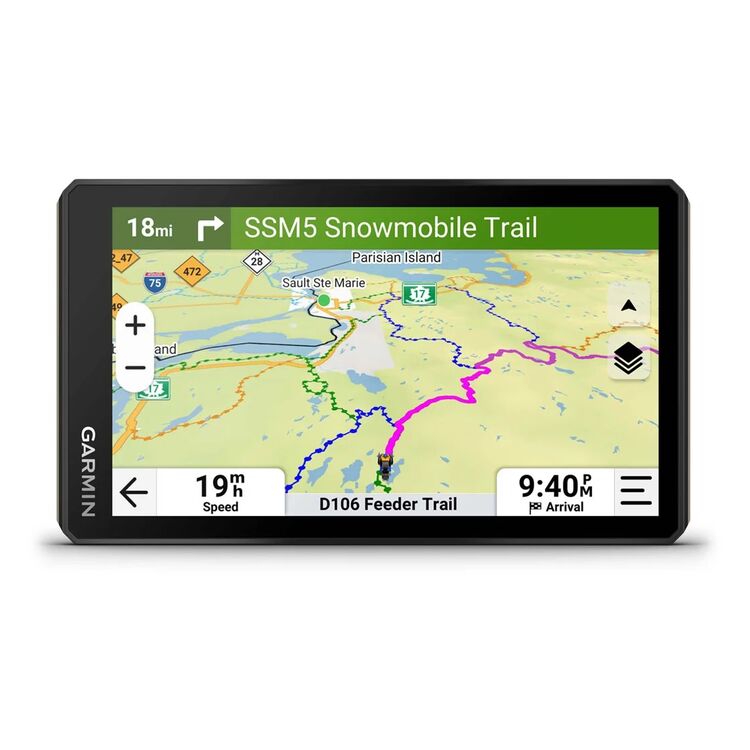



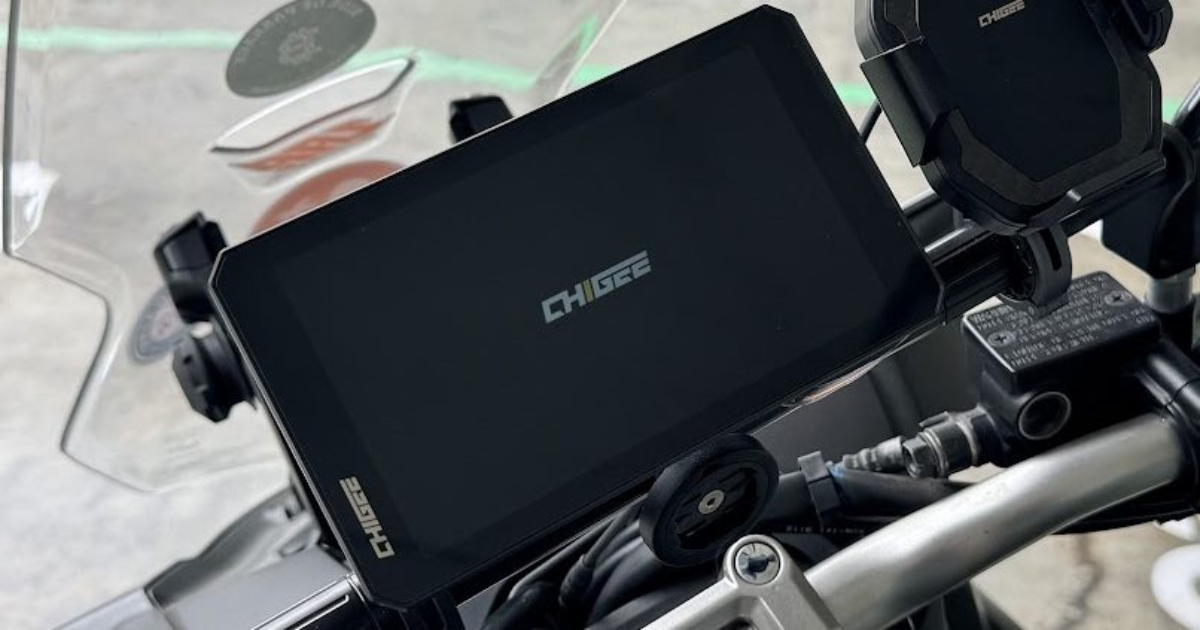
Bob B
5 months ago
Thank you for taking the time to put this together. I have a Zumo XT2. There are Bluetooth connectivity issues with the Tread App that are pretty annoying, but yes it does work as a standalone unit just fine.
I’ve been researching alternatives and something like this helps keep things into perspective. While the unit have doesn’t do it all as well as it should, nothing is perfect for every rider.
Evan Rally
5 months ago
Thank you Bob, this is super helpful commentary!